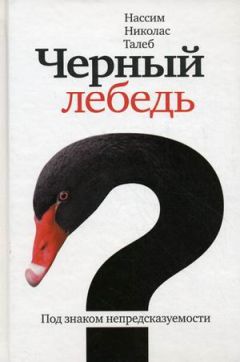Нассим Талеб - Чёрный лебедь. Под знаком непредсказуемости
Проблема скрытых свидетельств состоит в том, что, оглядываясь на прошлое, мы видим не всё, а только наиболее светлые моменты процесса.
Распределение вероятности — модель, используемая для вычисления шансов различных событий, то есть того, как они "распределяются". Говоря о гауссовом распределении, мы имеем в виду, что с помощью гауссианы можем просчитать вероятность различных событий.
Слепота в отношении Черного лебедя — недооценка роли Черного лебедя и иногда переоценка одного конкретного.
Случайность как неполная информация — часто мы не в состоянии предугадать событие потому, что наше знание о его причинах неполно, а вовсе не потому, что оно обладает свойствами, делающими его непредсказуемым.
Среднестан — область, где правит посредственность и где не часты оглушительные успехи или провалы. Ни одно отдельное наблюдение не может заметно повлиять на совокупную величину. В Среднестане берет свое начало гауссиана. Между гауссианой и степенными законами существует такое же качественное различие, как между газом и водой.
Статистический порочный круг (или проблема зацикленности статистики). Нам нужны данные, чтобы верно оценить распределение вероятностей, с которым мы имеем дело. Как нам узнать, что у нас их достаточно? Из распределения вероятностей. Если оно нормальное, то хватит нескольких точек. Как нам определить, что оно нормальное? На основании данных. Итак, нам нужны данные, чтобы понять, какое перед нами распределение вероятностей, и нам нужны параметры распределения вероятностей, чтобы понять, сколько данных нам нужно. Это порочный круг, который трудно преодолеть и который довольно бесстыдно обходят, прибегая к гауссиане и ее родичам.
Стратегия Апеллеса — стратегия поиска встреч с наибольшим количеством "добрых" Черных лебедей.
Стратегия "штанги" — метод, заключающийся в соединении оборонительного и крайне авантюрного подходов. Основная часть активов должна изолироваться от всех зон неопределенности, а их малая доля — пускаться в рискованную игру.
Футурологическая слепота — наша естественная неспособность принимать в расчет свойства будущего; сродни аутизму, который мешает принимать в расчет наличие других сознаний.
Эпилогизм — свободный от всяческих теорий подход к истории, состоящий в накоплении необобщаемых фактов и основанный на осознании опасности выискивания причин.
Библиография
Abarbanell, Jeffery S., and Victor L. Bernard, 1992, "Test of Analysts' Overreaction/Underreaction of Earnings Information as an Explanation for Anomalous Stock Price Behavior." Journal of Finance 47:1181-1207.
Aczel, Amir D, 2004, Chance: A Guide to Gambling, Love, the Stock Market, and Just About Everything Else. New York: Thunder's Mouth Press.
Adamic, Lada, 1999, "The Small World Web." Lecture Notes in Computational Science 1696: 443-452.
Adamic, Lada, and Bernardo A. Huberman, 1999, "The Nature of Markets in the World Wide Web." Quarterly Journal of Electronic Commerce 1:5-12.
Albert, R., and A.-L. Barabasi, 2000, "Topology of Evolving Networks: Local Events and Universality." Physical Review Letters 85:5234-5237.
Albert, R., H. Jeong, and A.-L. Barabasi, 2000, "Error and Attack Tolerance of Complex Networks." Nature 406: 378-382.
Albouy, Fran<;ois-Xavier, 2002, Le temps des catastrophes. Paris: Descartes &Cie.
Al-Ghazali, 1989, "Mikhtarat Min Ahthar Al-Ghazali." In Saliba, Jamil, Tarikh Al Falsafa AL Arabian. Beirut: Al Sharikah Al Ahlamiah Lilk-itab.
Allen, Mark S., 2006, "Transformations in Maori Warfare: Toa, Pa, and Pu." In Elizabeth N. Arkush and Mark W. Allen, 2006.
Allen, Michael, 2003, The Truth About Writing. Wiltshire: Kingsfield Publications.
--------, 2005, On the Survival of Rats in the Slushpile: Essays and Criticism. Wiltshire: Kingsfield Publications.
Allport, D. A., 1975, "The State of Cognitive Psychology." Quarterly Journal of Experimental Psychology 27:141-152.
Allwood, С. M., and H. Montgomery, 1987, "Response Selection Strategies and Realism of Confidence Judgments." Organizational Behavior and Human Decision Processes 39:365-383.
Alpert, M., and H. Raiffa, 1982, "A Progress Report on the Training of Probability Assessors." In D. Kahneman, P. Slovic, and A. TVersky, eds., 1982.
Amaral, L. A. N., A. Scala, M. Barthelemy, and H. E. Stanley, 2000, "Classes of Behavior of Small-world Networks." Proceedings of the National Academy of Science 97:11149-11152.
Anderson, Benedict, 1983, Imagined Communities. New York: Verso.
Anderson, Chris, 2006, The Long Tail. New York: Hyperion.
Anderson, N. H., 1986, "A Cognitive Theory of Judgment and Decision." In B. Brehmer, H. Jungermann, P. Lourens, and G. Sevon, eds., New Directions in Research on Decision Making. Amsterdam: North-Holland.
Angele, U., B. Beer-Binder, R. Berger, C. Bussmann, H. Kleinbolting, and B. Mansard, 1982, Uber-und Unterschatzung des eigenen Wissens in Ahhangigkeit von Geschlecht und Bildungsstand (Overestimation and Underestimation of One's Knowledge as a Function of Sex and Education). Unpublished manuscript, University of Konstanz, Federal Republic of Germany.
Angner, Erik, 2006, "Economists as Experts: Overconfidence in Theory and Practice." Journal of Economic Methodology 13(1): 1-24.
Annas, Julia, and Julian Barnes, 1985, Modes of Skepticism. Cambridge-Cambridge University Press. Arkes, H. R., C. Christensen, C. Lai, and C. Blumer, 1987, "Two Methods of Reducing Overconfidence." Organizational Behavior and Human Decision Processes 39:133-144.
Arkes, H. R., and K. R. Hammond, 1986, Judgment and Decision Making: An Interdisciplinary Reader. Cambridge: Cambridge University Press.
Arkush, Elizabeth N., and Mark W. Allen, eds., 2006, The Archaeology of Warfare: Prehistories of Raiding and Conquest. Gainesville: University of Florida Press.
Armelius, В., and K. Armelius, 1974, "The Use of Redundancy in Multiple-cue Judgments: Data from a Suppressor-variable task." American Journal of Psychology 87: 385-392.
Armelius, K., 1979, "Task Predictability and Performance as Determinants of Confidence in Multiple-cue Judgments." Scandinavian Journal of Psychology 20:19-25.
Armstrong, J. Scott, 1978, "Are Econometricians Useful? Folklore Versus Fact." Journal of Business 51(4): 549-564.
--------, 1981, "How Expert Are the Experts?" Inc., Dec. 1981:15-16.
Aron, Raymond, 1961, Dimensions de la conscience historique. Paris:Agora.
Arrow, Kenneth, 1987, "Economic Theory and the Postulate of Rationality." In J. Eatwell, M. Milgate, and P. Newman, eds., 1987, 2: 69-74.
Arthur, Brian W., 1994, Increasing Returns and Path Dependence in the Economy. Ann Arbor: University of Michigan Press.
Astebro, Thomas, 2003, "The Return to Independent Invention: Evidence of Unrealistic Optimism, Risk Seeking or Skewness Loving?" Economic Journal 113(484): 226-239.
Ashiya, Masahiro, and Takero Doi, 2001, "Herd Behavior of Japanese Economists." Journal of Economic Behavior and Organization 46:343-346.
Attewell, P., 2001, "The Winner-take-all High School: Organizational Adaptations to Educational Stratification." Sociology of Education 74: 267-295.
Ayache, E., 2004a, "The Back of Beyond," Wilmott (Spring): 26-29.
-----------, 2004b, "A Beginning, in the End," Wilmott (Winter): 6-11.
Ayer, A. J., 1958, The Problem of Knowledge. London: Penguin Books,
-------, 1972, Probability and Evidence. New York: Columbia University Press.
-------, 1988, Voltaire. London: Faber and Faber.
Ayton, P., and A. G. R. McClelland, 1997, "How Real Is Overconfidence?" Journal of Behavioral Decision Making 10:153-285.
Baddeley, Alan, 1997, Human Memory: Theory and Practice. London:Psychology Press.
Bak, Per, 1996, How Nature Works. New York: Copernicus.
Bak, P., and K. Chen, 1991, "Self-organized criticality." Scientific American 264:46-53.
Ball, Philip, 2004, Critical Mass: How One Thing Leads to Another. London: Arrow Books.
-------, 2006, "Econophysics: Culture Crash." Nature 441: 686-688.
Banavar, J. R., F. Colaiori, A. Flammini, A. Maritan, and A. Rinaldo, 2000, "A Topology of the Fittest Transportation Network." Physical Review Letters 84: 4745-4748.
Barabási, Albert-Laszlo, 2002, Linked: The New Science of Networks.Boston: Perseus Publishing.
Barabási, Albert-Laszlo, and Reka Albeit, 1999, "Emergence of Scaling in Random Networks." Science 286:509-512.
Barabási, Albert-Laszlo, Reka Albert, and H. Jeong, 1999, "Mean-field Theory for Scale-free Random Networks." Physica A 272:173-197.
Barabási, Albert-Laszlo, and EricBonabeau, 2003, "Scale-free Networks." Scientific American 288(5): 50-59.
Baranski, J. V., and W. M. Petrusic, 1994, "The Calibration and Resolution of Confidence in Perceptual Judgments." Perception and Psychophysics 55: 412-428.
Barber, В. M., and T. Odean, 1999, "Trading Is Hazardous to Your Wealth: The Common Stock Investment Performance of Individual Investors." Working Paper.
Barbour, A. D., and G. Reinert, 2000, "Small worlds." Preprint cond-mat/0006001 at http://xxx.lanl.gov.
Bar-Hillel, M., and W. A. Wagenaar, 1991, "The perception of randomness." Advances in Applied Mathematics 12(4): 428-454.
Baron, Jonathan, 2000, Thinking and Deciding, 3rd ed. New York: Cambridge University Press.
Barron, G., and I. Erev, 2003, "Small Feedback-based Decisions and Their Limited Correspondence to Description-based Decisions." Journal of Behavioral Decision Making 16:215-233.
Barrow, John D., 1998, Impossibility: The Limits of Science and the Science of Limits. London: Vintage.
Barrow, John D., and Frank J. Tipler, 1986, TheAnthropic Cosmological Principle. Oxford: Oxford University Press.
Barrow-Green, June, 1996, Poincare and the Three Body Problem. History of Mathematics, Vol. n, American Mathematical Society.
Barthélémy, M., and L. A. N. Amaral, 1999, "Small-world Networks: Evidence for a Crossover Picture." Physical Review Letters 82: 3180-3183.
Bastiat, Frédéric, 1862-1864, Oeuvres complétés de Frédéric Bastiat,6 vols. Paris: Guillaumin.
Batchelor, R. A., 1990, "All Forecasters Are Equal." Journal of Business and Economic Statistics 8(1): 143-144.
-------, 2001, "How Useful Are the Forecasts of Intergovernmental Agencies? The IMF and OECD Versus the Consensus." Applied Economics 33(2): 225-235.
Bates, Elisabeth, 1994, "Modularity, Domain Specificity, and the Development of Language." In D. C. Gajdusek, G. M. McKhann, and C. L. Bolis, eds., Evolution and Neurology of Language: Discussions in Neuroscience 10:1-2,136-149.
Bauman, A. O., R. В. Deber, and G. G. Thompson, 1991, "Overconfidence Among Physicians and Nurses: The 'micro certainty, macro certainty' phenomenon." Social Science and Medicine 32:167-174.
Bayer, Hans Christian, 2003, Information: The New Language of Science. London: Orion Books, Ltd.
Bechara, A., A. R. Damasio, H. Damasio, and S. W. Anderson, 1994, "Insensitivity to Future Consequences Following Damage to Human Prefrontal Cortex." Cognition 50:1-3, 7-15.
Becker, Lawrence C, 1998, A New Stoicism. Princeton, N.J.: Princeton University Press.
Bellamy, Edward, 1891, Cent ans apres, ou Van 2000, trad, de Panglais par Paul Rey; avec une pref. par M. Theodore Reinach. Paris: E. Dentu.
Benartzi, Shlomo, 2001. "Excessive Extrapolation and the Allocation of 401(k) Accounts to Company Stock," Journal of Finance 56(5): 1747-1764.
Benartzi, Shlomo, and Richard Thaler, 1995, "Myopic Loss Aversion and the Equity Premium Puzzle." Quarterly Journal of Economics 110(1): 73-92.
Bénassy-Quéré, Agnés, 2002, "Euro/dollar: tout le mondepeutse tromper. "La Lettre du CEPII 215.
Benkirane, R., 2002, La complexite, vertiges etpromesses: 18 histoires de sciences. Paris: Le Pommier.
Berger, Peter L., and Thomas Luckmann, 1966, The Social Construction of Reality: A Treatise in the Sociology of Knowledge. New York: Anchor Books.
Bernard, Andre, 2002, Rotten Rejections: The Letters That Publisher Wish They'd Never Sent. London: Chrysalis Books.
Bernard, Claude, 1878, La science experimental. Paris: J.-B. Bailliere.
Bernoulli, Daniel, 1954, "Exposition of a New Theory on the Measurement of Risk." Econometrica 22(1): 23-36.
Bernstein, Peter L., 1996, Against the Gods: The Remarkable Story of Risk. New York: Wiley.
Berridge, Kent C, 2003, "Irrational Pursuits: Hyper-incentives from a Visceral Brain." In I. Brocas and J. Carillo, eds., 2003.
Berry, M., 1978, "Regular and Irregular Motion, in Topics in Nonlinear Mechanics," ed. S. Jorna, American Institute of Physics Conference Proceedings No. 46,16-120.
Bevan, Edwyn, 1913, Stoics and Sceptics. Chicago: Ares Publishers, Inc. Bewes, Timothy, 2002, Reification: or The Anxiety of Late Capitalism. London: Verso.
Bewley, Ronald A., and Denzil G. Fiebig, 2002, "On the Herding Instinct of Interest Rate Forecasters." Empirical Economics 27(3): 403-425.
Bhalla, U. S., and R. Iyengar, 1999, "Emergent Properties of Networks of Biological Signalling Pathways. Science 283: 381-387.




